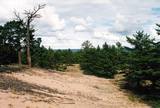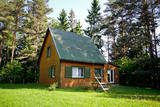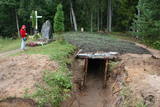| Nr | Name | Beschreibung |
|---|---|---|
|
Der Heilpflanzenhof „Kurmīši“ befindet sich in der sauberen und landschaftlich reizvollen Gegend des Naturparks Schleifen der Daugava, und dem Landschaftsschutzgebiet Obere Daugava. Damit die natürlichen Standorte der Heilpflanzen erhalten bleiben, werden auf dem Hof „Kurmīši“ seit 1994 etwa 40 Heilpflanzen (Arten und Sorten) angebaut. Für Liebhaber von Arzneipflanzen und sonstigen Besuchern werden Führungen zum Thema Anbau und Verarbeitung von Heilpflanzen sowie zur Imkerei auf dem Hof angeboten. Anschließend kann man die Erzeugnisse des Hofs, Kräutertees, die mit Honig am schmackhaftesten sind, verkosten und kaufen. Eine besondere Atmosphäre entsteht durch die Kerzen aus echtem Bienenwachs. Auf dem Hof sind Picknickplätze vorbereitet und es werden Kerzen gegossen. Entsprechend kann man auch edle Souvenirs aus Bienenwachs kaufen. |
||
|
Jeder, der Lettland bereist, kennt die Ortschaft Ēdole bei ihrem Schloss. Die Anfänge des Schlosses sind im 13. Jh. zu suchen, aber die Anbauten des Schlosses sind im 16. und 19. Jh. entstanden, als der Innenhof eingerichtet wurde. Während der Umbauten, die in den 1830er Jahren durchgeführt wurden, hat die Fassade des Schlosses die heutige – neogotische Gestalt bekommen. Ab dem 16. Jh. bis zum Jahr 1920 befand sich das Schloss von Ēdole im Besitz der Familie der Barone von Behr. In den Aufständen von 1905 wurde das Schloss niedergebrannt, aber im Jahr 1907 – erneuert. Das Schloss von Ēdole ist mit vielen Legenden und Spukgeschichten verbunden. |
||
|
Die Küstenbildungen des alten Ostseestadiums – Littorina-Meer treten in Natur als eine nicht große und flache Steilküste auf, die sich etwa vor 4500 – 5000 Jahren bildete. Ein Material der Küstenablagerungen – Geröll und Kies beinhalten ein für das Littorina-Meer kennzeichnendes reichstes Komplex der Faunareste. Am Besten ist der alte Meeres-Steilhang bei dem Hof “Dobeļi” in Kaltene zu beobachten. Der Steilhang der alten Küste in Kaltene ist einer der wenigen Abschnitte an der Küste der Rigaer Bucht, wo während des Littorina-Meeres eine Abrasionsküste war. In den flachen Meeresbuchten nähren sich und erholen sich die Zugvögel. (Die Quelle: Roja TIZ) |
||
|
Der Bau der Valmiera–Burg wurde 1283 angefangen. Im Laufe des Nordkrieges (1702) wurde die Burg verbrennt, aber am Ende des 17. Jh. wurden die Außenmauern der Stadt abgebaut. Es sind die Ruinen der Burg und die Reste der anderen mittelalterlichen Befestigungsanlagen erhalten. |
||
|
Das Gotteshaus war von 1932 – 1938 an der Stelle einer alten Holzkirche nach einem Projekt von J. Cīruļis erbaut worden. Bis 1994 befand sich hier ein Filmverleih. Heute kann man in der Kirche eine Fotoausstellung über den Bau der Kirche besichtigen – „Vom Fundament bis zur Turmspitze, alte lettische Kirchenbauämter in Fotografien. Vom 37m hohen Glockenturm aus hat man einen Blick über die Stadt . |
||
|
Metāla tornis Kazari upes kreisajā krastā, ~ 5 km attālumā no Matsalu līča. No torņa redzamās Kazari deltas palieņu pļavas atrodas tikai 0,3 – 1 m augstumā virs jūras līmeņa, tādēļ pavasara palos un stipru vētru (īpaši rietumvēju) laikā ūdens appludina milzīgu teritoriju. Uzskata, ka platības ziņā šīs ir vienas no lielākajām Eiropas palieņu pļavām, kas ir nozīmīga dažādu tārtiņveidīgo putnu sugu ligzdošanas, dzērvju un zosveidīgo putnu atpūtas un barošanās vieta. Ir pagājis laiks, kad zemnieki Matsalu pļavās ganīja govis un pļāva sienu, tādēļ šobrīd pļavu apsaimniekošanu veic nacionālā parka administrācija. |
||
|
Das Café Pärnamäed befindet sich an der Landstraße Via Baltica 10 km von Pärnu in Richtung Riga. Es spezialisiert sich auf Süßwaren, das Backen von Weißbrot und Schwarzbrot ohne Konservierungsstoffe und bietet auch Produkte verschiedener Kleinproduzenten an. Das Café bietet auch Suppen, Hauptgerichte und Desserts an. |
||
|
Neliela apdzīvota vieta nacionālā parka ziemeļrietumu daļā, kur kādreiz atradusies Rebases muiža. Mūsdienās no tās saglabājušās klēts atliekas, pie kurām apskatāms interesants vēstures liecinieks – sens akmens, ko izmantoja kulšanas procesā (Peksukivi). |
||
|
Eine einzigartige Kirche mit einem im 17. Jh. beiseite gebauten Glockenturm. |
||
|
Dabas liegums veidots ezera, tā salu, ainavas, augu, putnu un sikspārņu aizsardzībai. Liegumu var apskatīt "no malas" - no ceļa, kas iet gar tā ziemeļu un ziemeļaustrumu robežu.
|
||
|
This is a forested island in the Bay of Finland which is the 6th largest Estonian island and is found 14 km to the N of Tallinn. Two decades ago it was a closed zone, because the Soviet Union had a highly secretive manufacturing plant for maritime mines here.
|
||
|
Das Spa Hotel Lohja genießt eine wunderschöne Lage in der Nähe des Lohja-Sees, umgeben von friedlicher Natur. Hier können Sie ein Fahrrad und / oder Boot mieten, ins Fitnessstudio gehen, Minigolf spielen, schwimmen und vieles mehr. |
||
|
Das Schloss von Lielstraupe (deutsch Groß-Roop) ist das einzige erhaltene Gebäude in Lettland, das eine mittelalterliche Burg mit einer Kirche in sich verbindet. Mit dem Bau des Schlosses wurde im Jahr 1263 begonnen. Die Bebauung hat im 17. und 18. Jh., sowie in den Bauernaufständen von 1905 wesentlich gelitten. Der Gebäudekomplex wurde im Jahr 1909 laut den Plänen des Architekten Wilhelm Bockslaff erneuert. In der Kirche von Lielstraupe befinden sich mehrere Kunstdenkmäler, z.B. Malereien eines Orgelchors aus dem 17. Jh. und einer Kanzel aus dem 18. Jh. Im Jahr 1944 wurden in der Kirche die von dem Künstler Sigismunds Vidbergs geschaffenen Glasgemälde Golgatha und Geburt Christi aufgestellt. Auf dem Schlossturm kann man eine Uhr sehen, die der einheimische Uhrmacher Aide gemacht hat, aber auf der Kirchenwand – eine Sonnenuhr besichtigen. Im Schlosspark muss man den im Jahr 1744 aus Holz gebauten Glockenturm besichtigen. Im Jahr 1938 wurde in der Kirche eine Gedenktafel an die im Ersten Weltkrieg und in den Freiheitskämpfen Gefallenen enthüllt. Seit 1963 befindet sich in dem Schloss ein Krankenhaus für Narkologie. Die Kirche kann man während der Gottesdienste, aber die anderen Gebäude nur von außen besichtigen. |
||
|
Zemnieku saimniecība "Dzirnas" nodarbojas ar bioloģisko putnkopību, audzē zemenes un dārzeņus. Saimniecība apsaimnieko 11 ha zemes. Tajā iegūtās olas ar zīmolu "Vistu olas", sīpoli un ķiploki tiek pārdoti veikalos "Klēts" Rimi hypermārketos Rīgā. Savukārt zemenes pārdod dzimtajā Alsungā, kā arī pēc pieprasījuma piegādā Rīgā. Iespējams arī apmeklēt un apskatīt saimniecību, taču nepieciešmaa iepriekšēja pieteikšanās. |
||
|
Das Ferienhaus Sala und die Sauna am See Vertukšne bieten Beschäftigungen und Dienstleistungen an, die eine gesunde Lebensweise unterstützen. Kuren zur Körperreinigung und Gewichtsverlust, Farbtherapie oder die heilende Lichttherapie Bioptron pro 1. |
||
|
Im Oktober 1948 haben die gegen die sowjetische Macht gestimmten nationalen Partisanen in Wälder von Īle einen 9 x 6 m großen Bunker gebaut. Das Ziel war der Kampf gegen die existierende Ordnung und Ideologie. Fünf Monate später die Komitee der Staatssicherheitsdienst ging zum Angriff gegen diesen Bunker vor. Nach fünf Stunden langen Kampf sind 15 Partisanen ums Leben gekommen und 9 Partisanen wurden gefangengenommen.
|
||
|
Im Angebot Naturtouren: Flosswanderungen im Frühjahr, Kajaktouren im Sommer (beim Wunsch auch inklusive Biberbeobachtung), ganzjährige Schneeschuhwanderungen in den Moorgebieten von Estland, im Winter Kick-Sled Touren. Erfahrene Wanderführer erzählen spannende Geschichten über die Natur und Kultur von Estland. |
||
|
Viena no 19. gs. sešdesmito gadu sākumā būvētās St. Pēterburgas – Varšavas dzelzceļa līnijas stacijām. Kaut arī sliežu ceļš joprojām turpinās Baltkrievijas virzienā (tālāk – pamests), Marcinkones dzelzceļa stacija ir pēdējā, līdz kurai pasažieri var nokļūt ar vilcienu no Viļņas (3 reizes dienā). Arī kravas vilcieni tālāk nekursē. Stacijas ēka ir izcils koka arhitektūras un stacijas kompleksa apsaimniekošanas piemērs. No Marcinkones dzelzceļa stacijas virzienā uz Čepkeļu purvu savulaik ir bijis izveidots šaursliežu dzelzceļš, kuru izmantoja kokmateriālu izvešanai. Tā vietā šobrīd ir saglabājies vecs meža ceļš, kur plānots izvietot šaursliežu dzelzceļu tematikai veltītu informācijas stendu. |
||
|
Rukši ir bioloģiskā saimniecība, kura audzē HEREFORD šķirnes liellopus, bariņu blējošas aitas ,vistas. Ar ambiciozu skatienu nakotnē par iespējām nodrošināt ar kvalitatīvu liellopu gaļu visus izsalkušos. |
||
|
Die bedeutendste Periode der Stadt ist mit der Zeit von 1561 bis 1795 verbunden, als der Kreis von Jelgava dem Herzogtum von Kurland und Semgallen gehörte. Als Jelgava zur Residenz des Herzogs (1567) und zur Hauptstadt des Herzogtums (1616) wurde, blühte die Stadt schnell auf. Der höchste Punkt der Entwicklung war in der Regierungszeit des Herzogs Jacob. In der Regierungszeit der letzten zwei Herzoge – Ernst Johann von Biron und seines Sohnes Peters – wurde die Academia Petrina (1775) – die erste Hochschule in Lettland – gegründet, im Jahr 1816 wurde die Gesellschaft für Literatur und Kunst gegründet, im Jahr 1822 wurde die erste lettische Zeitung Latviešu Avīzes veröffentlicht, im Jahr 1802 wurde das erste Theatergebäude, aber im Jahr 1898 – das erste Museumsgebäude in Lettland gebaut. Im Jahr 1937 zog im Schloss von Jelgava die Lettische Landwirtschaftskammer ein, aber in zwei Jahren wurde die Landwirtschaftliche Akademie von Jelgava geöffnet. Im Sommer 1944 wurden fast die ganze historische Bebauung und die Kunstwerte der Stadt zerstört. Nach dem Zweiten Weltkrieg wurde Jelgava erneuert. Vor einer kurzen Zeit wurde auch der Turm der Heiligen Dreieinigkeitskirche erneuert, wo zurzeit eines der besten interaktiven Museen in Lettland (kinder- und familienfreundlich) eingerichtet ist. |
||

























